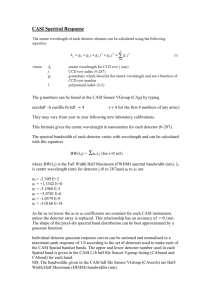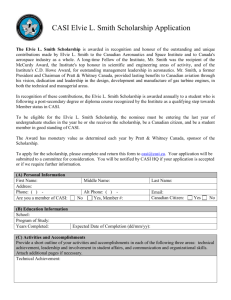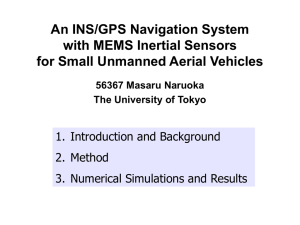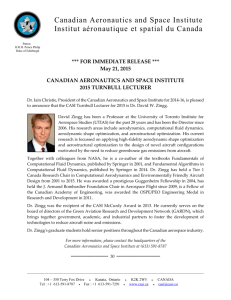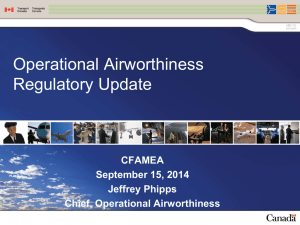AIRBORNE SENSOR INTEGRATION AND DIRECT ORIENTATION OF THE CASI SYSTEM
advertisement
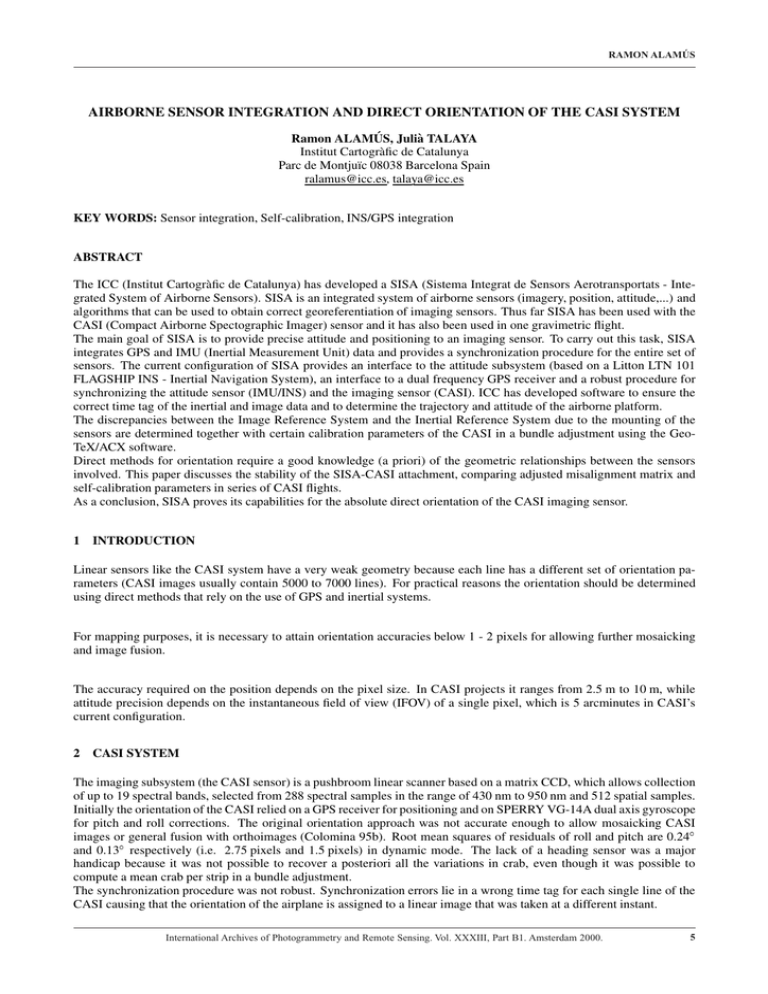
RAMON ALAMÚS AIRBORNE SENSOR INTEGRATION AND DIRECT ORIENTATION OF THE CASI SYSTEM Ramon ALAMÚS, Julià TALAYA Institut Cartogràfic de Catalunya Parc de Montjuı̈c 08038 Barcelona Spain ralamus@icc.es, talaya@icc.es KEY WORDS: Sensor integration, Self-calibration, INS/GPS integration ABSTRACT The ICC (Institut Cartogràfic de Catalunya) has developed a SISA (Sistema Integrat de Sensors Aerotransportats - Integrated System of Airborne Sensors). SISA is an integrated system of airborne sensors (imagery, position, attitude,...) and algorithms that can be used to obtain correct georeferentiation of imaging sensors. Thus far SISA has been used with the CASI (Compact Airborne Spectographic Imager) sensor and it has also been used in one gravimetric flight. The main goal of SISA is to provide precise attitude and positioning to an imaging sensor. To carry out this task, SISA integrates GPS and IMU (Inertial Measurement Unit) data and provides a synchronization procedure for the entire set of sensors. The current configuration of SISA provides an interface to the attitude subsystem (based on a Litton LTN 101 FLAGSHIP INS - Inertial Navigation System), an interface to a dual frequency GPS receiver and a robust procedure for synchronizing the attitude sensor (IMU/INS) and the imaging sensor (CASI). ICC has developed software to ensure the correct time tag of the inertial and image data and to determine the trajectory and attitude of the airborne platform. The discrepancies between the Image Reference System and the Inertial Reference System due to the mounting of the sensors are determined together with certain calibration parameters of the CASI in a bundle adjustment using the GeoTeX/ACX software. Direct methods for orientation require a good knowledge (a priori) of the geometric relationships between the sensors involved. This paper discusses the stability of the SISA-CASI attachment, comparing adjusted misalignment matrix and self-calibration parameters in series of CASI flights. As a conclusion, SISA proves its capabilities for the absolute direct orientation of the CASI imaging sensor. 1 INTRODUCTION Linear sensors like the CASI system have a very weak geometry because each line has a different set of orientation parameters (CASI images usually contain 5000 to 7000 lines). For practical reasons the orientation should be determined using direct methods that rely on the use of GPS and inertial systems. For mapping purposes, it is necessary to attain orientation accuracies below 1 - 2 pixels for allowing further mosaicking and image fusion. The accuracy required on the position depends on the pixel size. In CASI projects it ranges from 2.5 m to 10 m, while attitude precision depends on the instantaneous field of view (IFOV) of a single pixel, which is 5 arcminutes in CASI’s current configuration. 2 CASI SYSTEM The imaging subsystem (the CASI sensor) is a pushbroom linear scanner based on a matrix CCD, which allows collection of up to 19 spectral bands, selected from 288 spectral samples in the range of 430 nm to 950 nm and 512 spatial samples. Initially the orientation of the CASI relied on a GPS receiver for positioning and on SPERRY VG-14A dual axis gyroscope for pitch and roll corrections. The original orientation approach was not accurate enough to allow mosaicking CASI images or general fusion with orthoimages (Colomina 95b). Root mean squares of residuals of roll and pitch are 0.24Æ and 0.13Æ respectively (i.e. 2.75 pixels and 1.5 pixels) in dynamic mode. The lack of a heading sensor was a major handicap because it was not possible to recover a posteriori all the variations in crab, even though it was possible to compute a mean crab per strip in a bundle adjustment. The synchronization procedure was not robust. Synchronization errors lie in a wrong time tag for each single line of the CASI causing that the orientation of the airplane is assigned to a linear image that was taken at a different instant. International Archives of Photogrammetry and Remote Sensing. Vol. XXXIII, Part B1. Amsterdam 2000. 5 Ramon Alamús 3 THE SISA SYSTEM In order to meet the orientation requirements of the CASI system, SISA (Sistema Integrat de Sensors Aerotransportats, Integrated System of Airborne Sensors) was developed with a more robust synchronization interface, a more accurate attitude subsystem and a position subsystem. SISA is the system used to integrate GPS data and IMU data, and to provide a synchronization procedure for the entire set of sensors. The current configuration of SISA consists of different subsystems that interface: to the attitude subsystem (IMU), to a dual frequency GPS receiver and to the imaging sensor. It also provides a robust procedure for synchronizing the attitude sensor (IMU) and the imaging sensor (CASI) to GPS time. 1.1 1.2 2.1 2.2 3 1 Figure 1: Set up of the whole system: SISA (1) –GPS receiver Ashtech Z-12 (1.1), and INS LTN 101 (1.2)–, the CASI (2.1 CASI head sensor, 2.2 control unit) and CCNS-4 navigation system (3) in the Partenavia P-68 Observer. 3.1 Attitude Subsystem In order to determine the orientation parameters in a direct way, the ICC bought an LTN 101 FLAGSHIP INS (Inertial Navigation System) which contains a highly accurate IMU (Inertial Measurement Unit). The IMU integrates three dual frequency zero-lock RLG (Ring Laser Gyro) gyroscopes and three silicon linear accelerometers. The gyros were hand-picked by Litton for the ICC according to long-term stability criteria. The interface to the IMU can be realized through the ARINC 429 industry standard or through Litton’s proprietary FLAGCAL/DART SW/HW interface provided to ICC. 3.2 Position Subsystem The position subsystem provides an interface to a GPS dual frequency receiver for collecting raw measurements and for synchronizing the whole system. 3.3 Imaging Subsystem SISA was designed for orienting any sensor (laser scanner, digital cameras, etc.) that meets certain synchronization requirements. The current imaging subsystem is the CASI sensor, but the SISA has also been used in one gravimetric flight. 6 International Archives of Photogrammetry and Remote Sensing. Vol. XXXIII, Part B1. Amsterdam 2000. Ramon Alamús 3.4 Synchronization Subsystem The design of the synchronization procedure has been based on the particular requirements of the INS for accepting external timing pulses. The LTN 101 is only able to interface to a GPS receiver through the ARINC 429 protocol, but in order to have access to the raw INS data, the ARINC 429 interface was not used. Since the LTN 101 is able to detect a pulse and embed it in its data, the synchronization procedure is based on the generation of a sequence of pulses by SISA, the SISA time tags the pulses and by a posterior correlation it synchronizes the LTN 101 data. 3.4.1 CASI Modifications Following requirements specified by the ICC, ITRES modified the CASI hardware to allow the use of different IMUs and an external independent time synchronization of the CASI frames. After the modification, during the integration time of each line the CASI generates a pulse (pulse per frame, ppf) and a frame identifier, which are sent to SISA to allow the synchronization of the CASI images. 4 DATA PROCESSING Once all the primary data have been collected (image, GPS, IMU, auxiliary data) they have to be combined to determine the direct orientation of the images. 4.1 GPS Data Processing The GPS data are processed using TraDer. TraDer is a GPS processing software developed at ICC for the determination of GPS trajectories. TraDer is capable of using a network of GPS reference stations for a robust estimation of the ambiguities and a precise determination of the flight path. 4.2 INS Data Processing The INS has to be aligned in order to provide orientation to the images. There are two possibilities for the alignment: initial static alignment with the airplane engines off, and an in-flight alignment combining GPS and INS data. If the INS is aligned before the flight then the observational errors of the IMU will degrade the orientation during the flight; however, the accuracy of the INS used (LTN-101) is good enough for orienting the CASI (it has to be kept in mind that the IFOV of a pixel is about 0.1 degree). 4.3 Synchronization The position and angular information recorded by the orientation subsystems has to be synchronized with the image lines. A pseudo-random sequence of pulses is generated by SISA. The INS has embedded the sequence of pulses in its records. For the synchronization procedure of the INS data, the pseudo-random sequence of pulses is extracted from the INS records and correlated with the sequence of time tags stored by SISA. The pulse per frame generated by the image sensor allows the synchronization of the image subsystem. 4.4 Bundle Adjustment There are some geometrical parameters that have to be applied in order to translate the orientation from the position/attitude sensors (GPS, IMU) to the image sensor. Also, the CASI sensor did not have a geometric laboratory calibration so the optical parameters of the sensor (focal length and principal point) have to be refined from the initial nominal values. The offset between the GPS antenna and the image sensor can be determined directly using topographic procedures. The antenna offset has to be measured at a precision level consistent with the pixel size (not very critical in the case of the CASI, where the pixel size is above 1m). This offset can be considered constant as long as the image sensor is mounted in the same place in the airplane. There is also an angular misalignment between the axis of the reference system of the CASI head sensor and the axis of the reference system of the INS. It is necessary to compute this misalignment matrix between the image reference system (the one related to the CASI) and the reference system of the INS. An important issue is the study of the stability of this misalignment matrix. International Archives of Photogrammetry and Remote Sensing. Vol. XXXIII, Part B1. Amsterdam 2000. 7 Ramon Alamús To carry out the determination of these parameters, tie and ground points are identified in the images and a bundle block adjustment is performed to determine the matrix misalignment. The block adjustment is done using GeoTeX/ACX (Colomina 92). Due to the weakness of the CASI geometry, the calibration parameters and the misalignment matrix have a very high correlation. To reduce that correlation a calibration flight with two strips flown in opposite directions was flown. Also, an important capability of the GeoTeX software is that it allows for the simultaneous adjustment of different flights solving for a single set of calibration parameters. 5 SYSTEM CALIBRATION The geometric calibration of the whole system (imaging sensor calibration and misalignment matrix) is studied throughout a series of CASI flights performed by the ICC since 1998. The analysis was carried out using flights at different heights (consequently with different pixel sizes), scanning frequencies (Integration Times) and spectral configurations. The strip configurations of the flights are different, a fact that allows conclusions to be drawn on which block configurations are more suitable for the system calibration. Flight area date height (m) IT (ms) Pixel size (mm) No. Strips Garrotxa Benifallet Bellmunt Gaia 1998/07/23 1998/08/04 1998/08/19 1998/10/10 2160 6140 659 2471 48 90 16 55 3.53.5 10.010.0 1.01.0 4.04.0 14 1 5+2T 1 Valls Ribarroja 1 Vallromanes 1 Ribarroja 2 Vallromanes 2 1999/07/23 2000/03/02 2000/03/02 2000/03/04 2000/03/04 2473 2477 2477 2477 2477 55 60 60 60 60 4.04.0 4.04.0 4.04.0 4.04.0 4.04.0 1 3 5 3 5 Table 1: Summary of flights. The table 1 contains the list of all the flights used in this study. In the flights with only one strip (Benifallet, Gaia and Valls) the strip was flown twice in different directions. In the blocks of Garrotxa and Bellmunt the strips were flown alternatively from North to South and from South to North. The Bellmunt block has 2 additional transversal strips. In the blocks of Ribaroja 1 and 2, the 3 strips were flown with opposite headings varying alternatively. Finally, in the blocks of Vallromanes 1 and 2, the 5 strips were flown as in the Ribaroja blocks, but the central strip was flown twice (in both directions). In all blocks GPS observations and INS/IMU attitude observations are used for aerial control. In addition to aerial control, ground points were identified and measured from digital orthophoto maps, 1:25000 map scale orthophotos (2.5 meter pixel size) for all the blocks but 1:5000 scale ones (0.54 meter pixel size) for Bellmunt, which pixel size is 11 meter. Heights of the ground control were obtained from ICC’s countrywide elevation database. Accuracy of the orthophoto maps used is about 2.5 m (1:25000 scale) and 1 m (1:5000 scale). Accuracy of the elevation database is better than 2 m (1- level). In most of the blocks, tie points, not measured in the orthophoto maps, have been identified and measured. DTM as surface control is introduced as well in the adjustment to better determine the focal length camera parameter. All blocks before the year 2000 were adjusted to determine sensor calibration parameters (differences of focal length and principal point from the nominal values) and misalignement matrix between the image reference system and the IRS (Inertial Reference System). The results of these adjustments are shown in table 2. The first observation is that focal length parameter is well determined independent of the flying height, which means that the adjusted value of the focal length is actually due to a miscalibration of CASI focal length. Adjusted parameters for the Garrotxa and Bellmunt blocks are very similar to those for the Benifallet and Gaia blocks. However these parameters are very different between the Garrotxa - Bellmunt blocks and Benifallet - Gaia blocks. The block design (see table 2) is correlated to the adjusted parameters. A new adjustment was carried out using the Garrotxa and Benifallet blocks. In this adjustment there was only a set of camera calibration parameters, common for both blocks, and a set of matrix misalignment parameters for each block (one for Garrotxa and the second one for Banifallet). The adjusted camera parameters are Æf = 0:6478mm, Æx0 = 1:97m 8 International Archives of Photogrammetry and Remote Sensing. Vol. XXXIII, Part B1. Amsterdam 2000. Ramon Alamús Flight area Æf mm Æx0 m Garrotxa Benifallet Bellmunt Gaia 0.6496 0.6481 0.6318 0.6558 -12.74 (-0.9) 2.02 ( 0.1) -10.75 (-0.7) -4.90 (-0.3) Valls 0.0010 53.19 ( 3.6) Æy0 m -64.52 ( 7.31 ( -62.17 ( 11.14 ( -4.3) 0.5) -4.2) 0.7) -622.67 (-41.5) ! deg Æ 0 00 ' deg deg 5:6) 0:7) 5:3) 0:8) -0Æ 00 200 (0:0) Æ 0 00 0 0 2 (0:0) -0Æ 00 600 (0:0) Æ 0 00 0 0 1 (0:0) -0Æ 10 1400 (-0:2) -0Æ 40 200 (-0:8) -0Æ 50 2800 (-1:1) -0Æ 140 300 (-2:7) -0Æ 90 5100 (-1:9) -0Æ 00 600 (0:0) -0Æ 360 5500 (-7:1) 0 29 2 ( Æ 0 00 0 3 31 ( Æ 0 00 0 27 49 ( Æ 0 00 0 4 17 ( Table 2: Adjusted parameters of independent adjustments (equivalence to pixels in brackets) . Æf mm Æx0 m Æy0 m Garrotxa Benifallet Bellmunt Gaia 0.0030 0.0090 0.0100 0.0153 24:83 (1:7) 24:03 (1:6) 24:02 (1:6) 33:12 (2:2) 17:73 (1:2) 22:70 (1:5) 18:67 (1:2) 32:99 (2:2) Valls 0.0047 12:30 (0:8) 9:72 (0:7) Flight area ! arcsec 00 (1:2) 345 00 440 00 370 00 647 00 (1:5) (1:2) (2:2) 201 (0:7) ' arcsec 00 (1:7) 512 00 494 00 496 00 680 00 (1:7) (1:7) (2:3) 271 (0:9) arcsec 00 (0:2) 56 00 165 00 94 00 278 (0:6) (0:3) (0:9) 00 89 (0:3) Table 3: Standard deviations of adjusted parameters in table 2 (equivalence to pixels in brackets) . and Æy0 = 7:04m and respectively their precision is Æf = 0:0013mm, Æx0 = 1:47m (i.e. 0.1 pixels) and Æy0 = 1:47m (i.e. 0.1 pixels). . It has to be noticed that these values are closer to the adjusted parameters in the Benifallet block of table 2 than to the Garrotxa ones. So block design has a high influence in the right determination of the highly correlated parameters: principal point and misalignment matrix. The determination of the camera parameters is better if the block has a strip flown twice (each time with a different heading). The adjusted camera calibration parameters were fixed in the following adjustments to determined the new values for the matrix misalignment parameters (see table 4). Flight area Garrotxa Benifallet Bellmunt Gaia ! deg Æ 0 00 0 5 54 (1:1) Æ 0 00 0 3 36 (0:7) Æ 0 00 0 5 31 (1:1) Æ 0 00 0 5 17 (1:0) ' deg Æ 0 00 0 4 59 (1:0) Æ 0 00 0 0 1 (0:0) Æ 0 00 0 3 43 (0:7) Æ 0 00 0 2 23 (0:5) deg ! arcsec ' arcsec arcsec -0Æ 10 3800 (-0:3) -0Æ 40 200 (-0:8) -0Æ 50 2400 (-1:0) -0Æ 140 300 (-2:7) 33” (0.1) 50” (0.2) 35” (0.1) 72” (0.2) 35” (0.1) 54” (0.2) 37” (0.1) 79” (0.3) 57” (0.2) 165” (0.6) 96” (0.3) 278” (1.0) Table 4: Adjusted misalignment matrices and standard deviations with fixed camera parameters (pixel equivalence in brackets). Differences of ! , ' and are less than one pixel (about 5 arcminutes). It should be noted that the whole platform CASIINS was removed between one flight and the next one, detaching the INS from the CASI. Despite this fact, table 4 shows the stability of the CASI-INS mounting and the stability of the misalignment matrix. The difference in the adjusted camera and misalignment matrix parameters for the Valls block and the blocks flown before 1999 is due to the fact that CASI was sent to Itres to be upgraded and repaired during the beginning of 1999. Concerning the other blocks, as yet not mentioned: Ribaroja 1 and Vallromanes 1 were flown in an airplane during the same flight. Afterwards, the SISA-CASI platform was removed from the first airplane and installed in the second one without detaching the INS from the CASI platform, and the images of the Ribaroja 2 and Vallromanes 2 blocks were taken. As the flights are close in time (the second flight was flown two days later than the first one) it can be assumed that the camera parameters had to be the same. Due to these considerations, the Ribaroja 1 and 2 and Vallromanes 1 and 2 blocks were processed together. In the common adjustment of the four blocks a unique set of camera calibration parameters and a misalignment matrix was determined for each block (see table 5). In a second adjustment a unique set of camera calibration parameters and a unique misalignment per flight (table 6) were computed. In table 5 are shown the adjusted misalignment matrices. The adjusted camera parameters are Æf = 0:0262mm, Æx0 = 42:04m and Æy0 = 402:53m and their respective precisions are Æf = 0:0068mm, Æx0 = 16:8m (i.e. 1.12 pixels) and Æy0 = 15:94m (i.e. 1.06 pixels). International Archives of Photogrammetry and Remote Sensing. Vol. XXXIII, Part B1. Amsterdam 2000. 9 Ramon Alamús ! deg Flight area Ribarroja 1 Vallromanes 1 Ribarroja 2 Vallromanes 2 -1Æ 250 5400 (-16:5) -1Æ 220 2100 (-15:8) -1Æ 240 4900 (-16:3) -1Æ 230 5400 (-16:1) ' deg deg ! arcsec -0Æ 120 2300 (-2:4) -0Æ 100 3900 (-2:0) -0Æ 70 2600 (-1:5) -0Æ 140 2200 (-2:8) -0Æ 360 1400 (-6:9) -0Æ 380 2000 (-7:4) -0Æ 330 2900 (-6:4) -0Æ 350 2200 (-6:8) 341 (1:1) 00 332 (1:1) 00 336 (1:1) 00 332 (1:1) 00 ' arcsec 00 376 (1:2) 00 372 (1:2) 00 377 (1:2) 00 373 (1:2) arcsec 00 276 (0:9) 00 207 (0:7) 00 309 (1:0) 00 218 (0:7) Table 5: Misalignment matrices and standard deviations (pixel equivalence in brackets). Table 6 shows the adjusted misalignment matrices. The adjusted camera parameters are Æf = 0:0228mm, Æx0 = 30:51m and Æy0 = 325:46m and their respective precisions are Æf = 0:007mm, Æx0 = 19:0m (i.e. 1.27 pixels) and Æy0 = 17:21m (i.e. 1.15 pixels). ! deg Flight area Ribarroja & Vallromanes 1 Ribarroja & Vallromanes 2 ' deg deg ! arcsec -1Æ 490 4000 (-21:0) -0Æ 150 2700 (-3:0) -0Æ 380 3200 (-7:4) 357 (1:1) -1Æ 500 5600 (-21:3) -0Æ 160 4000 (-3:2) -0Æ 350 1500 (-6:8) 356 (1:1) ' arcsec 00 419 (1:3) 00 420 (1:3) arcsec 00 159 (0:5) 00 00 171 (0:6) 00 Table 6: Misalignment matrices and standard deviations (pixel equivalence in brackets). Note that the high correlation between principal point and ! and ' of the misalignment matrix, together with the fact of a weak geometry of the CASI sensor, makes it difficult to achieve a good determination of both sets of parameters. Moreover, the fact of the low redundancy of image observations does not help in such a determination. 6 CONCLUSIONS As discussed in (Alamús 99) SISA meets the requirements to orientate the CASI. Direct orientation methods require a good knowledge of the geometric relations between the image sensor and the orientation sensor. Concretely, laboratory calibration of the imaging sensor is required. Otherwise, the high correlation between principal point and misalignment matrix parameters renders the determination of these parameters in a Bundle adjustment more difficult. Despite this, the SISA system is capable of being successful in the determination of camera calibration parameters and misalignment matrix. The best block configuration to achieve the in-flight calibration of the CASI sensor parameter jointly with the misalignment matrix is a block with 3 or more parallel strips flown in opposite directions and with the central strip flown in both directions. This configuration allows the maximum redundancy in image observation of ground and tie points. In case such a block configuration cannot be flown, a minimum configuration is a single strip flown twice in both directions. Due the stability of the misalignement matrix shown in tables 5 and 6 and if the INS sensor and the CASI head sensor unit are not detached from the airborne platform – as in blocks Ribaroja 1, Vallromanes 1, Ribaroja 2 and Vallromanes 2 – and the calibration of the CASI is known, then the misalignment matrix variations are in the range of 1 pixel. Therefore, in projects with relaxed requirements for the precision of the orientation parameters, the misalignment matrix could be computed from a prior flight. In order to ensure the stability of the misalignment matrix, neither the INS nor the CASI should be detached from the CASI-INS mounting. 7 ACKNOWLEDGEMENTS The CASI-501 system was funded by the DGR-CIRIT (Direcció General de Recerca - Comissió Interdepartamental de Recerca i Innovació Tecnològica). Litton LTN 101 was funded by Comissionat per a Universitat i Recerca (Ref. PIR949915) and Dirección General de Investigación Cientı́fica y Tecnológica (Ref. IN94-0210). 10 International Archives of Photogrammetry and Remote Sensing. Vol. XXXIII, Part B1. Amsterdam 2000. Ramon Alamús REFERENCES (Alamús 99) Alamús,R.,Talaya,J.,Colomina,I.,1999. The SISA/0: ICC experiences in airborne sensor integration. Joint Workshop of ISPRS WG I/1, I/3 and IV/4: SENSORS AND MAPPING FROM SPACE 1999., Hannover, Germany (Baulies 94) Baulies,X.,1994. The CASI’91 campaign in Catalonia. Terra. Revista Catalana de Geografia,Cartografia i Ciències de la Terra, Vol. 9, pp. 19–27. (Colomina 92) Colomina,I.,Navarro,J.,Térmens,A.,1992. GeoTeX: a general point determination system. International Archives of Photogrammetry and Remote Sensing, Vol. 29, Comm. III, pp. 656–664. (Colomina 95) Colomina,I.,Talaya,J.,Baulies,X.,1995. The N.O.S.A. project and concept for sensor orientation. 3rd International Workshop HIGH PRECISION NAVIGATION, Stuttgart, Germany. (Colomina 95b) Colomina,I.,Alamús,R.,Palà,V.,Castillo,M.,1995. First experiences with the CASI scanner at the ICC. 3rd International Workshop HIGH PRECISION NAVIGATION, Stuttgart, Germany. International Archives of Photogrammetry and Remote Sensing. Vol. XXXIII, Part B1. Amsterdam 2000. 11
